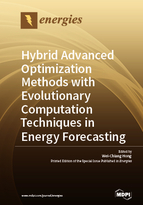Hybrid Advanced Optimization Methods with Evolutionary Computation Techniques in Energy Forecasting
A special issue of Energies (ISSN 1996-1073).
Deadline for manuscript submissions: closed (31 December 2017) | Viewed by 51569
Special Issue Editor
Interests: short-term load forecasting; intelligent forecasting technologies (e.g., neural networks, knowledge–based expert systems, fuzzy inference systems, evolutionary computation, etc.); hybrid forecasting models (e.g., hybridizing traditional models with intelligent technologies, or hybridizing two or more different models to form a novel forecasting model); novel intelligent methodologies (chaos theory; cloud theory; quantum theory)
Special Issues, Collections and Topics in MDPI journals
Special Issue Information
Dear Colleagues,
More accurate, or more precise, energy demand forecasts is required while energy decisions are made in a competitive environment. Particularly, in the Big Data era, forecasting models are always based on a complex function combination, and energy data are always complicated; examples include seasonality, cyclicity, fluctuation, dynamic nonlinearity, and so on. These forecasting models have resulted in an over-reliance on the use of informal judgments and higher expenses when lacking the ability to determine data characteristics and patterns. The hybridization of optimization methods and evolutionary computation techniques can provide important improvements via well parameter determinations in the optimization process, which is of great assistance to actions taken by energy decision-makers.
This Special Issue aims to attract researchers with an interest in the research areas described above. Specifically, we are interested in contributions towards the development of any hybrid advanced optimization methods (e.g., quadratic (nonlinear) programming theory, chaos theory, fuzzy theory, cloud theory, quantum theory, differential empirical mode, and so on) with evolutionary computation techniques (e.g., genetic algorithms, evolutionary algorithms, ant colony algorithm, immune algorithm, bacterial foraging algorithm, swarm intelligence, and so on), which have superior capabilities over the traditional optimization approaches to overcome some embedded drawbacks, and, then, apply these advanced hybrid approaches to enhance the capabilities of original forecasting models to significantly improve forecasting accuracy. For example, the hybrid cloud theory with the simulated annealing algorithm (CSA), by introducing a cloud generator to the temperature annealing process, can randomly generate a group of new values that distribute around the given value like a “cloud”. The fixed temperature point of each step can be transformed into a changeable temperature zone, in which the temperature of each state generated at every annealing step can be randomly chosen, the course of temperature change in the entire annealing process is assumed to be continuous, which is the required condition of a physical annealing process. Eventually, the hybrid approach can reach more ideal solutions. These kind of hybrid approaches require more detailed research and empirical studies. On the other hand, some new trials, namely combined approaches, such as single seasonal mechanism, multiple seasonal mechanism, longitudinal seasonal mechanism, and cross-sectional seasonal mechanism, etc., combined with forecasting models, are also welcome.
All submissions should be based on the rigorous motivation of the mentioned approaches and all developed models should also have corresponding sound theoretical framework, not having such a scientific approach is discouraged. Validation of existing/presented approaches is encouraged to be done using real practical applications.
Prof. Dr. Wei-Chiang Hong
Guest Editor
Manuscript Submission Information
Manuscripts should be submitted online at www.mdpi.com by registering and logging in to this website. Once you are registered, click here to go to the submission form. Manuscripts can be submitted until the deadline. All submissions that pass pre-check are peer-reviewed. Accepted papers will be published continuously in the journal (as soon as accepted) and will be listed together on the special issue website. Research articles, review articles as well as short communications are invited. For planned papers, a title and short abstract (about 100 words) can be sent to the Editorial Office for announcement on this website.
Submitted manuscripts should not have been published previously, nor be under consideration for publication elsewhere (except conference proceedings papers). All manuscripts are thoroughly refereed through a single-blind peer-review process. A guide for authors and other relevant information for submission of manuscripts is available on the Instructions for Authors page. Energies is an international peer-reviewed open access semimonthly journal published by MDPI.
Please visit the Instructions for Authors page before submitting a manuscript. The Article Processing Charge (APC) for publication in this open access journal is 2600 CHF (Swiss Francs). Submitted papers should be well formatted and use good English. Authors may use MDPI's English editing service prior to publication or during author revisions.
Keywords
- Hybrid models
- Optimization methods
- Evolutionary algorithms
- Energy forecasting
- Support vector regression
- Chaos theory
- Fuzzy theory
- Cloud theory
- Quantum theory
- Single seasonal mechanism
- Multiple seasonal mechanism
- Longitudinal seasonal mechanism
- Cross-sectional seasonal mechanism






